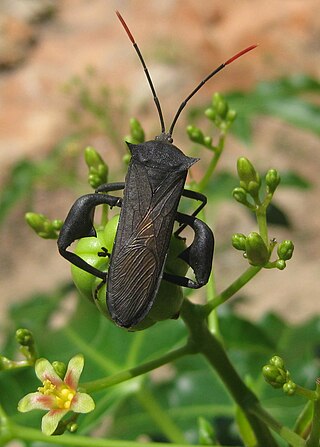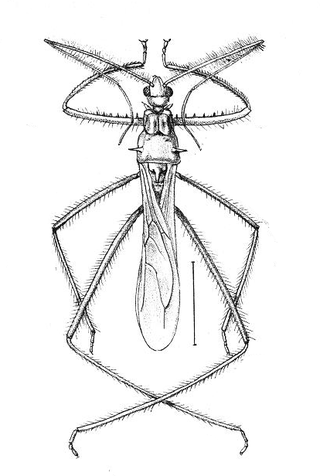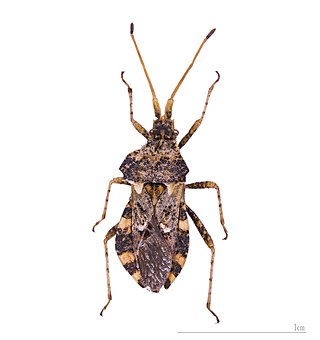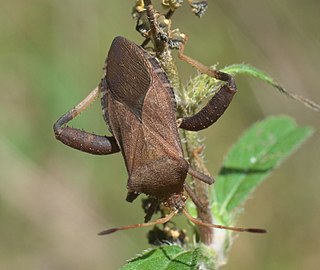
Coreidae is a large family of predominantly sap-sucking insects in the Hemipteran suborder Heteroptera. The name "Coreidae" derives from the genus Coreus, which derives from the Ancient Greek κόρις (kóris) meaning bedbug.

Alydidae, commonly known as broad-headed bugs, is a family of true bugs very similar to the closely related Coreidae. There are at least 60 genera and 300 species altogether. Distributed in the temperate and warmer regions of the Earth, most are tropical and subtropical animals; for example Europe has a mere 10 species, and only 2 of these occur outside the Mediterranean region.

The Harpactorinae are a large subfamily of the Reduviidae. About 300 genera and 2,000 species worldwide have been described. Some of the species of the genera Zelus, Pselliopus, Sinea, and Apiomerus are of interest as biological pest control agents.

The Fidicinini are a tribe of cicadas. There are at least 20 genera and 250 described species in Fidicinini, found in the Nearctic and Palearctic.

The Ectrichodiinae are a subfamily of assassin bugs (Reduviidae) known for specializing on millipedes as prey. The group comprises more than 600 species in about 115 genera, making it a fairly large subfamily. The bugs are also known for their aposematic coloration, often brightly colored metallic blue, red, or yellow.

Harpactorini is a tribe of the Harpactorinae. This group is the most diverse of the entire assassin bug family, with 51 genera recognized in the Neotropical Region and 289 genera and 2003 species overall.

The Reduviinae are a subfamily of the reduviid assassin bugs. Many members of the subfamily are nocturnal and their lifecycles are generally poorly known. This subfamily is suspected not to be monophyletic.

The Peiratinae are a subfamily of assassin bugs (Reduviidae) known as corsairs. The subfamily has a worldwide distribution, but is concentrated in tropical areas. About 30 genera with 350 species are described.

Saicinae is a subfamily of the family Reduviidae, or the assassin bugs.

Acanthaspis Amyot & Serville, 1843, is a genus of assassin bugs. Members of the genus are known to disguise themselves by attaching bits of debris to aid in camouflage.

Coreini is a tribe of leaf-footed bugs in the family Coreidae. There are at least 20 genera and 70 described species in Coreini.

Cydninae is a subfamily of burrowing bugs in the family Cydnidae. There are about 11 genera and at least 40 described species in Cydninae.

Carpocorini is a tribe of stink bugs in the family Pentatomidae. There are more than 100 genera in Carpocorini.

Acanthocephalini is a tribe of leaf-footed bugs in the family Coreidae. There are at least 100 described species in Acanthocephalini found in the Americas.

Pachygronthidae is a family of true bugs in the order Hemiptera. There are about 14 genera and more than 80 described species in Pachygronthidae.

Acanthocerini is a tribe of leaf-footed bugs in the family Coreidae. There are at least 20 genera and 50 described species in Acanthocerini.

Stegaspidinae is a subfamily of treehoppers in the family Membracidae.

Ectinoderus is a genus of Asian bugs in the family Reduviidae. It is the type genus of the tribe Ectinoderini: the 'Oriental resin bugs'.

Salyavatinae are a subfamily of the assassin bugs. They have a pan-tropical distribution with about 16 genera. They have two foretarsal segments and have a patch of fine hairs known as the fossula spongiosa on the fore and mid tibia. Many species tend to have spines on the head, pronotum, legs and abdomen. A few species have the foretibia flattened into leaf-like structures.





















